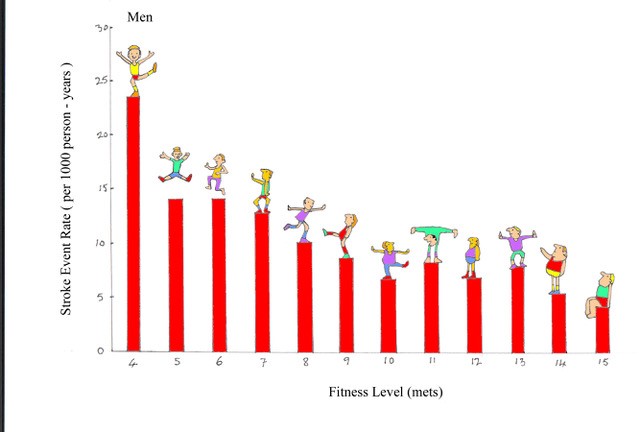EXERCISE AND STROKES
What is a stroke?
A stroke is “a serious life-threatening medical condition that happens when the blood supply to part of the brain is cut off” (NHS). The affected area of the brain loses its supply of oxygen and nutrition, resulting in rapid and irreversible loss of brain tissue. The most common cause of strokes is atheroma with narrowing of the arteries supplying the brain, the “cerebral” arteries. A less common cause is a bleed due to the bursting of a cerebral artery. In some cases this is due to a weakness or congenital abnormality in the artery.
It is the atheromatous stroke which I will be talking about. Atheroma of the cerebral arteries has much the same provoking factors as atheroma elsewhere – smoking, dyslipidaemia, high blood pressure, obesity and diabetes. High blood pressure is a particular risk factor for cerebral atheroma.
The symptoms of a stroke
The most recognisable form of stroke is sudden onset of one sided paralysis or weakness, known as a hemiplegia. However, any region of the brain can be involved and may result in such disparate loss of function as loss of speech, severe giddiness, changed behaviour, numbness, sight loss or confusion.
Sometimes damage to the brain is minor, but repeated episodes may lead to “vascular” dementia. This is covered in my blogs on Dementia.
Apart from weakness, long-term problems are usual among stroke survivors. The most common include poor mobility (58%), fatigue (52%), loss of concentration (45%), and falls (44%).
According to the Stroke Association there are more than 100,000 strokes in the UK each year and more than 1.2 million stroke survivors, many with severe ongoing disabilities. Stroke is the fourth biggest killer in the UK and costs the country about £26 billion annually.
Immediate management
There has been a public Health campaign to get stroke victims into medical care as quickly as possible. This is the “FAST” campaign – F (facial weakness), A (Arms, one side being weaker than the other), S (Speech which may be slurred), T (Time which indicates that immediate action is needed). The sooner the victim can be admitted to a stroke unit the more likely that the blood supply can be restored to the brain either by clot busting drugs or by opening the blocked artery with a stent.
Exercise for preventing strokes:
Regular exercise reduces several of the risk factors which are known to be important provokers of strokes – high blood pressure, obesity, diabetes and dyslipidaemia. It would be impossible to carry out a long–term, large-scale randomised controlled trial of exercise for prevention. However observational studies confirm that the incidence of stroke is between 20% and 70% lower in those who are physically active compared with those who are not. Moreover there is a dose-response relationship between the amount of exercise taken and the reduction in risk. Both duration of exercise and frequency are related to the reduction in risk – the longer you exercise and more often you do it. Both reduce your stroke risk.
As you might expect, therefore, physical fitness is also closely related to stroke risk. One study of over 16,000 healthy men showed this strikingly. Those in the high fitness group had less than one third the risk of dying from stroke of those in the low fitness group. A study from the Cooper Institute followed 20,000 adults who had been fitness tested and found a similar inverse relationship between physical fitness and stroke risk with a dose-response relationship – that is to say the fitter the subject, the lower the risk.
The illustration at the head of this blog shows the increasing risk of stroke with decreasing fitness – the least fit having nearly five times greater risk than the fittest.
Next week I will tell you about the use of exercise for treating stroke survivors.
Subscribe to the blog
Categories
- Accelerometer
- Alzheimer's disease
- Blood pressure
- BMI
- Cancer
- Complications
- Coronary disease
- Cycling
- Dementia
- Diabetes
- Events
- Evidence
- Exercise promotion
- Frailty
- Healthspan
- Hearty News
- Hypertension
- Ill effects
- Infections
- Lifespan
- Lipids
- Lung disease
- Mental health
- Mental health
- Muscles
- Obesity
- Osteoporosis
- Oxygen uptake
- Parkinson's Disease
- Physical activity
- Physical fitness
- Pregnancy
- Running
- Sedentary behaviour
- Strength training
- Stroke
- Uncategorized
- Walking


